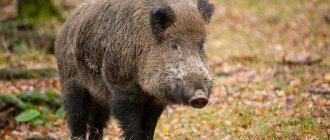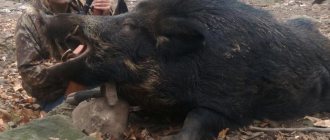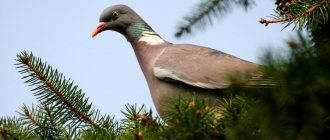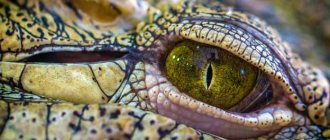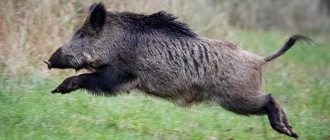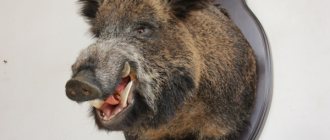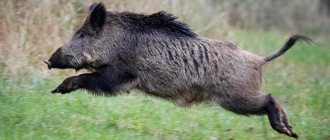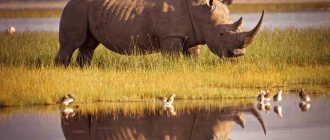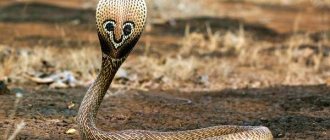The wild boar is a representative of the artiodactyl order. This animal is also called a boar. Tamed by distant ancestors, he became the progenitor of domestic pig breeds. In areas where there are a lot of wild boars, the animals can harm the forest. Wild boars destroy bird nests and feed in fields and vegetable gardens. Boars can attack hunters and pose a serious danger. To learn about safety when meeting a wild boar, you should study its habits.
Description and features
The description of a wild boar should begin with an idea of its considerable volume. The body length of animals varies from one and a half meters to 175 cm. The weight of the average animal is approximately 100 kg, although among wild boars it is not uncommon to weigh 150 or even 200 kilograms.
Thus, the size of such mammals is truly enormous. In addition, the height of animals can reach 1 meter, which, as a rule, is more than half the height of a person.
The appearance of these wild animals is nothing special. Their body is covered with rather coarse and hard fur of a dark color: gray, brown or black. The coat of the ancestors of pigs is not pleasant to the touch and is somewhat reminiscent of hard household brushes.
Comparing a boar accustomed to life in the wild and a domestic pig, you can notice a colossal difference between them. Wild boars spend their entire lives in the forest, so they are more adapted to such an environment.
Their fur reliably protects them from the cold, strong and long legs allow them to move quickly, taking long walks, their ears are rather large and point upward so that the animal can always sense danger.
The boar's nickel is not very sensitive, which allows the animal to loosen the soil and leaves without being injured
The snout patch is not particularly sensitive, so it is difficult to injure it while searching for food in the forest. What are the different types of wild boars in the wild ?
Unforeseen collision
If all precautions have been taken, but a dangerous surprise still occurs, you need to follow some rules to avoid consequences. What to do if you meet a wild boar in the forest?
Take into account a few of the most important techniques. You shouldn't run, you need to stay calm. The boar will smell the person and leave, not seeing the danger.
But if the boar is scared, angry, or you met him during the rutting period, or disturbed a female with piglets, then things are bad. When the animal attacks, nothing can scare it.
If a boar is angry, it knows no fear. And since the animal runs fast (30 km/h), it will catch up with a person in no time. Therefore, there is no point in fleeing from him. But he is not able to slow down or turn to the side. Therefore, the correct way out of this dangerous situation is to jump to the side. But this requires good skill. Few people have managed such a trick. If you manage to do this, you can consider yourself saved - the boar rarely comes back. If he nevertheless rushes a second time, you must again jump to the side and dodge until you reach the shelter.
There is no point in defending yourself, it will not bring results. A knife blow or shot must be very well aimed and aimed at the eye, neck or ear.
There is a safer option - climb a tree and sit there for a while. At first the boar will watch you below, but after a while he will leave.
Types of wild boars
The boar genus does not include a very large number of species. To date, only about 20 different species of mammals have been bred. All these types are conventionally divided into Western, Eastern, Indian and Indonesian. Let's talk about some of them in more detail.
Central European
Representatives of this species are widespread in different European countries, as well as in the European part of Russia. Such wild boars can often be seen in zoos and nature reserves.
The Central European species is not distinguished by its enormous volumes. These animals are characterized by a small body length - approximately 130-140 cm. Their weight reaches average values - about 100 kg.
These boars are not considered particularly dangerous to humans. In relation to those who care for them, they behave calmly and respectfully, and are distinguished by flexible behavior. However, such mammals should still be isolated from the public, since their natural aggression can manifest themselves at any time.
Central Asian
Most species of large wild boars received their name precisely because of the distribution area of the animals. Thus, representatives of the Central Asian subspecies live in Central Asia, Afghanistan, Kazakhstan and Mongolia.
The animals of Central Asia are larger in size than those of Central Europe. Their height is on average 150-160 cm, and their body weight can reach 120-130 kg.
The fur of Central Asian wild boars can be either light or dark in color. The most common is gray-brown hair. The fur of these animals is not very dense, which is explained by their constant residence in areas with a fairly hot climate. The animals have managed to adapt to this habitat, and they feel very comfortable in it.
Indian
Representatives of this species are included in a not very numerous group of Indian species. Animals are common in India, Nepal, Sri Lanka and neighboring countries.
The peculiarity of Indian wild boars is that they are not afraid of people. They calmly, without fear, go out into the steppe regions and collect their favorite delicacies. Local residents are also not afraid of these animals and never behave aggressively.
The fur of representatives of the Indian species is light in color. This is due to the fairly warm climate and natural features of the area.
Despite the easy-going behavior of these wild boars, you should not threaten them or their cubs. These mammals, caring for their offspring, always retain their natural instincts and can cause significant harm to the guilty person.
Ussuri
The habitat of this species is a fairly vast area. Ussuri wild boars live in China, as well as in the lands of the Far Eastern region of Russia, near the Amur and Ussuri rivers. Sometimes this species is also called Far Eastern.
Representatives of this species are the largest of all existing ones. With a normal height of 170-18 cm, their body weight reaches 250-350 kg. Such impressive volumes make this boar potentially dangerous to anyone who crosses its path.
The hairline is dark in color, varying from gray-brown to black. Due to their size, these animals are extremely strong and resilient. They are able to travel long distances and pursue anyone who threatens their herd or their family.
The meat of wild boars of this species is highly valued by local residents, so about a quarter of the total number of representatives is exterminated annually by hunters and poachers.
The largest representatives of this species are found precisely on the territory of Russia, in the Primorsky Territory.
Japanese
The Japanese wild boar lives in Japan, with the exception of some islands. Representatives of the species have large body sizes and dark thick fur.
From the outside, these animals look very massive, even huge. This idea is due to the significant amount of fat that they “eat” on purpose. Their rough, but at the same time, sensitive spot on their elongated snout allows them to obtain all the necessary food products.
These mammals are calm and peaceful, so they are often kept in various zoos and nature reserves.
Natural enemies
Boars have their enemies. These are wolves, bears or lynx. Wolves attack in packs. First, one of them, jumping on top of the boar, throws it to the ground, then the whole flock attacks him. Lynx most often attacks young individuals that have strayed from the herd. She jumps on his back, inflicting severe and fatal wounds.
The bear is the most terrible enemy. Attacking the cleaver, the bear squeezes the animal with its powerful paws, and it dies from broken bones.
Habitat
The mammals we are considering, for the most part, are not on the verge of extinction. Only a few species, especially those suffering at the hands of local hunters, are considered rare. However, the entire genus of wild boar, as is known today, is not in danger of extinction.
For this reason, wild boars are distributed almost everywhere. As mentioned earlier, they are divided into four main groups depending on their habitats. The Western and Eastern groups are considered the most numerous.
Representatives of these species are distributed throughout most European and Asian countries. They easily adapt to their environment and learn to find food and a safe place to live.
The most “poor” areas in terms of wild boars are considered to be North and South America, as well as Antarctica. There are special local species on American soil, but biologists do not classify them as part of the main classification of the genus.
Habits
The habits of a wild boar are quite interesting.
These animals are very sensitive to temperature changes. To avoid sunburn and to protect themselves from various insect bites, they are thoroughly smeared in mud.
An important condition for these animals to live is the presence of a body of water near the rookery.
The habits of wild animals force the boar to stay away from people. They approach populated areas extremely rarely, but forays into fields where oats or corn grow are made regularly.
The boar leads a sedentary lifestyle. During the summer months, it only emerges from its hiding place to feed. Then he comes back again to rest.
In winter, the wild boar's habits do not change. The wild boar also moves little in winter, since the snow does not allow it to go far. The wild boar, despite its clumsiness, is an excellent swimmer.
Lifestyle
Boars are considered very thrifty and prudent animals that take care of themselves and their offspring in advance.
Mammals, as a rule, live in small groups, or herds, uniting from 10 to 40 individuals. The herd is headed by a female, and there may be several times fewer males in the group.
The greatest activity of animals occurs precisely in the spring-summer period. In winter, they move a little, trying to retain warmth and energy.
Wild boars have very good eyesight and sense of smell. Thanks to their large erect ears, they hear perfectly. They can move through the forest silently, unnoticed by predators and humans. These mammals, despite their body mass, are excellent swimmers and can easily overcome long and difficult distances.
Commercial value
The main valuable products that can be obtained from wild boar fishing are bristles, meat and skin . Slaughter weight in winter is 10% higher than in summer. On average, one wild boar carcass can provide a hunter with 50 kilograms of meat. The area of the resulting skin reaches 300 square decimeters.
This is interesting! They hunt wild boars by lying in wait at watering places or staying in group feeding areas. Hunting with dogs is also practiced.
This animal leaps across open areas with lightning speed, carefully looking around and sniffing before doing so. The boar also develops considerable speed, which makes it impossible to aim properly. An encounter with an angry boar may be the last for an inexperienced hunter, blinded by passion.
Return to content
Nutrition
The ancestors of modern pigs, like the pigs themselves, are classified as omnivores. You can often see wild boars in photos burrowing in the ground. This activity is indeed the main way of obtaining food for animals.
They “feel” the earth in search of food, make sure it is suitable for consumption, and only after that eat it. Often these mammals are even compared to humans due to the similarity of their diet to that of humans.
Boars mainly eat plant foods: seeds and fruits, various parts of plants, tree bark, and mushrooms. However, their diet includes small animals. These include insects, arthropods, amphibians, reptiles and even some mammals. Wild boars also often feed on the remains of dead animals.
It is considered interesting that wild boars are not afraid of poisoning from dangerous lizards and snakes. When eating these animals, they do not pay attention to poisons. Indeed, substances that could be fatal to other living organisms pose absolutely no danger to wild pigs.
For these land-based mammals, it is vital to ensure that they do not have to suffer from starvation in the near future. Therefore, in warm weather, in the summer and in the summer, the wild boar “ attacks” food.
During this period of time, he is able to gain up to 10 kg every month. Later, when cold weather sets in, a significant layer of fat will prevent the animal from freezing and will also provide the necessary “reserve” of nutrients.
These omnivores themselves often become victims of other mammals. They are often attacked by predators, from which it can be difficult for wild boars to escape.
Video
You will find interesting facts about the life of a boar in our video.
Pigs are cute, clean animals and have a developed sense of smell. Everyone knows that these eared animals are similar to humans. And someone wondered: how many years do pigs of different breeds live in different conditions? It is difficult to answer the question in one word: you need to consider the circumstances of the pig’s life, taking into account the characteristics of the animal’s breed. Even the sex of the animal can affect the life cycle of a pig.
It is noteworthy that when asked how long a domestic pig lives, there may be conflicting and confusing answers. Each livestock breeder has his own opinion. The fate of domestic piglets is not enviable. Instead of the 10-15 years of a well-fed and carefree existence promised by nature, fate measures her a 1.5-year existence, ending in slaughter. Although large breeds of pigs that receive quality care could celebrate their 35th birthday (here the statement about the dependence of the life expectancy of an animal on its size is quite true)!
Reproduction
As a rule, a female gives birth to five to seven cubs, which she carefully cares for. Pregnancy does not last long - no more than 5 months. The body weight of a newborn is only 1 kilogram. The cubs are born in mid-spring, sighted, with a striped coat color.
On the tenth day of life, piglets are able to cover considerable distances, following their parents. They also begin to eat vegetation and learn to get the most juicy and tasty food.
Already at the age of one year, small boars weigh more than 50 kg. Thus, in the first year of life they gain more than 20 kg per season. At the same age, they lose their special coloring, acquiring the dark hair of adult boars.
Having reached the age of one and a half years, the piglets leave the “parental home” and go in search of a new home. They form new herds, learn to live independently and take care of each other.
The right choice when purchasing
We list the main factors that influence how many years pigs live at home:
- type and breed of animal;
- pig nutrition;
- living conditions (walking, housing);
- diseases and prevention.
Whatever breed of pig you choose, you need to follow the rules.
First, choose a piglet with a weight according to its breed and age. Ideally, you should also look at the pet’s parents, because from them he receives immunity and within a year he will become similar in appearance to them.
Secondly, the pig should not have visible skin defects or bent limbs. Liveliness and mobility indicate health. If she has a dull look and sluggish movements, then she is sick and there is a possibility that she will not live long.
Lifespan
On average, wild boars live in the wild for 10 to 15 years. Considering the fact that already at the age of one and a half years, piglets begin an independent life, this life expectancy is considerable.
The life of individual representatives of the genus can end even before 10 years. In their natural habitat, animals are threatened by various predators, as well as people who are keen on hunting.
According to recent studies, for every 400 thousand individuals there are about 40 thousand animals killed by hunters and poachers. Hunting for these animals is worth talking about separately.
Disease Prevention
Timely vaccination is the key to the longevity of any animal kept in captivity. Scheduled administration of vaccines builds the pig’s immunity and helps cope with parasites, viruses, and bacteria. From birth, pigs are vaccinated against worms and diseases that are registered in the region of residence. There are diseases that lead to premature death of pigs. Veterinarians call rickets dangerous. This disease affects the entire body of the piglet. The cardiovascular system and organs of the musculoskeletal system suffer.
To reduce the likelihood of diseases, animals are provided with optimal living conditions, checked for the presence of worms, dewormed in a timely manner, and treated for infectious and viral diseases.
The life of pigs is also extended in other ways. Boars are castrated, they live longer after castration. The number of pregnancies in sows is monitored. Bearing and feeding offspring exhausts the body. On a farm and a private farmstead, the life of meat piglets lasts 7-9 months; tallow piglets are sent for slaughter later, after 10 months. Breeding boars and sows are kept for 5-6 years. Under optimal conditions, pigs raised not for slaughter live for several decades.
Wild boar hunting
Hunting wild boars is considered an extremely profitable and exciting activity. Many people kill animals for their valuable and nutritious meat, thick and beautiful wool, or for no reason, to acquire a new hunting trophy. However, when hunting such mammals, you should pay attention to many nuances. What are the features of such an unsafe hobby?
First of all, it is worth saying that hunting such large animals is an extremely risky business. It poses a danger not only to animals, but also to the hunters themselves. The fact is that boars are very difficult to seriously injure.
If, for example, you get into the fat layer in the abdominal area, you can cause only minor damage to the animal. However, even such damage will greatly anger the boar, and it will be capable of causing serious harm to the attacker.
Even if it hits other parts of the body, you can avoid hitting vital organs and only “drive the beast out of yourself.” Therefore, inexperienced hunters are not recommended to choose wild boar as their prey.
Also, these animals can attack hunters and not alone. Members of their herd often come to the aid of their comrades, even sacrificing their own lives.
Often people go hunting with their dogs. However, in this way they only endanger their assistants. Dogs, inferior to wild boars in body size and weight, are sometimes much more vulnerable than humans themselves.
Comfortable living conditions
The pig needs personal space; the ideal would be to give it a separate room or at least build a personal house.
A miniature pig can live in an apartment; to create a personal space, you can use:
- a ready-made house from a pet store;
- make a bedding from soft rags;
- give your pet an old chair or trestle bed at his disposal;
- use a cardboard box.
It is better to insulate dangerous objects and wires from a curious mini pig. Close the lower cabinets and remove sharp objects away.
It is quite simple to train an animal to relieve itself in a certain place. It is better to place your pet's tray in the bathroom. You should choose a large tray with low sides.
Water treatments
Taking a bath prolongs your pet's life and saves you from unpleasant odors. The piglet should be bathed as needed. Usually piglets are happy to go for a swim. Dwarf breeds practically do not shed and do not have a repulsive odor.
Wash with a soft brush and soapy water. Buy a special shampoo with neutral PH for your piglet at a pet store or pharmacy. Do not use detergents, they can corrode delicate skin or cause allergies in your pet.
Daily walks
Lack of walks can have a negative impact on the piglet’s weight and lead to atrophy of the musculoskeletal system. For a pig to live for many years, you need to walk for at least 40 minutes every day. To prevent your piglet from getting lost, walk with a leash and learn the “nearby” command. Its essence lies in simultaneous movement to the left of the owner.
Medical care
Piglets are social animals and seek to be in the company of other animals or their owner. They are characterized by unstable immunity and a tendency to many diseases that arise due to stress, poor nutrition, drafts, and neglect of hygiene rules. Pigs living in urban areas may suffer from diseases: dyspepsia, colibacillosis, salmonellosis, conjunctivitis, keratitis, ear mites, otitis, rhinitis, laryngitis, streptococcal infection, plague, erysipelas.
If the pig doesn't want to play and is in a lethargic state, it's time to sound the alarm. The owner of mini pigs should contact a veterinarian as soon as possible if strange behavior or an increase in body temperature is noticed in a sick pet.
To prolong the quality of life of a piglet, you should undergo a medical examination and vaccinations at least twice a year. It's better to have a vaccination book. You should definitely check your pet for the presence of helminths in the body and take treatment measures.
Where does it live?
The Indian Historical Range extends to Europe, the Middle East, India, most of the Asian continent, and northern Africa. Wild boars, which are found in America and Australia, are the feral ancestors of domestic pigs brought there by colonists.
Where does he live?
The traditional habitat of the wild boar is deciduous and mixed forests. The crowns of trees and shrubs that descend to the ground provide shelter for the animal and also provide food. You can meet a wild boar near rivers and swamps, where it hides in reed thickets. Wild boars also live in mountainous regions.
Habits
Wild boars lead a predominantly gregarious lifestyle. They gather in herds that include several females and their young. Adult males prefer to live separately and join groups only during the rut. When two loppers join the herd, skirmishes occur between them for the right to cover the females.
During the daytime, the animals hide in a den made of branches and grass. The shelter is usually located in thickets of bushes or tall grass. Wild boars overwinter in pits: they tear up the snow, dig out last year's leaves and lay down on them.
Despite its threatening appearance, the wild boar is a cautious animal: it moves carefully through the forest, and upon hearing loud sounds or foreign odors, it immediately hides in a shelter and remains there, waiting out danger.
Raptor-HS Clothing store for hunters, fishermen and tourists
The technique of feeding a wild boar from simple to complex and more effective with examples and specific recommendations.
Step 1. Find resting, feeding or trail areas for the wild boar.
Wild pigs love to wallow in puddles to cool off in hot weather, so tracks near large puddles and large flat pieces of mud indicate the presence of wild boars in the area. Wild pigs love to rub against trees, so traces of fur are easy to spot. Paths leading to fields or to water are also clearly visible in the forest. Finding such places gives you a serious advantage. Now you need to find a place where you can feed the wild boars. Having started feeding the wild boar in the place where it often walks, you can, by moving the bait, move the place of bait to a place convenient for you, for example, to the edge of the forest (if you started from a path along the edge of the forest).
Step 2. Simple bait, in order to decide whether you have found a boar or only it seems to you.
Minimum costs and simplicity. Soak 2-3 kg of corn in water until the water smells sour. Gently mix the corn with the soil along the boar path and pour generously with the water in which the grain was soaked. To enhance the effect, you can use attractants like Hog Wild. If the boars have found the bait, you can start moving the bait to a place convenient for you. If we haven’t found it, we continue searching or just wait.
Step 3.
If you were able to lure the wild boar to a place convenient for you, in other words, he began to visit your bait, but not regularly yet, move on to the next step. Most likely, you do not have the opportunity to feed him daily, and the amount of food is small. We move on to measures to increase feeding time in order to keep the boar on the bait for a longer time. The least expensive way to keep a wild boar on bait for several hours is to make several holes in the ground approximately 1 m deep at a distance of 2-3 meters from each other; corn is poured into the holes; it is better to use pre-soaked corn on top (see Step 1) and attractants. like Hog Wild.
Costs: grain, drill and your suffering when drilling holes. Having prepared all this during the day, in the evening you can climb into the storage shed and wait for dusk, when the wild boars come out. Issues of organizing a warehouse are not discussed in this material; everyone has their own path.
The second option , also very simple and effective, is to use a PVC pipe with holes and corn inside. A metal stake is hammered at the intended feeding site and a PVC pipe with corn is attached to it on a metal chain. How to make such a pipe (here), and where to buy a ready-made one (here). The option with a pipe is more effective because it allows you to use not only the aromatic component of the bait, but also the acoustic one, which works much better (more details here). Then everything is the same as with pits.
Step 4.
This is a development of step 3. You were able to lure the wild boars to a place convenient for you, you do not have the opportunity to feed the wild boars every day, but you want to increase the likelihood of a successful hunt to the maximum. In this case, automatic boar feeders are used.
These devices allow you to distribute feed in the quantity you specify at the regularity you set. You can put grain in the feeder before you leave, come back a week later, hunt, top up the feed, and leave until the next weekend. Pros: the boar receives food very regularly, gets used to the place and time of feeding and begins to visit the feeder every day. Three people know the time and place: you, the boar and God. Cons: The feeder costs more than PVC pipe, is easier to spot and can be stolen. Options and prices for such feeders can be viewed (here). How to hide a feeder (section is being written), there is a lot of room for creativity.
Feeders can be hung on a tree, they can be installed on tripods, the size of the barrel is also determined by you. For greater efficiency, it is good to use attractants like Hog Wild. And most importantly, in the case of using an automatic boar feeder, you can use remotely controlled illumination (IR or regular) very effectively, which significantly increases the likelihood of a good shot in the dark.
Step 5. You are deservedly lucky and you have caught a wild boar.
Congratulations from the bottom of my heart. In order to butcher a wild boar, there are also convenient devices: your favorite hunting knife and a block hanger, which will significantly simplify the procedure. I also recommend using gloves; they will keep your clothes clean and your hands protected from infections that may occur in the wild.
